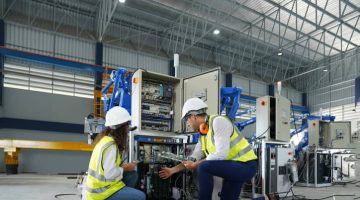Written by: Eric Whitley
Lean manufacturing is a systematic approach to minimizing waste while maximizing productivity in the manufacturing process. Central to this method is the role of data flow — the continuous and precise movement of information throughout the manufacturing system.
Effective data flow is essential for identifying inefficiencies, making informed decisions, and implementing real-time solutions to improve overall operational performance. This article explains the eight steps required for an accurate data flow in Lean manufacturing.
Step 1: Integrate Smart Manufacturing Tools
Specific smart manufacturing tools, such as Internet of Things (IoT) sensors, automated data collection systems, and advanced analytics software, are vital in enhancing data accuracy and improving manufacturing processes. These tools collect, analyze, and present data in a usable format.
These tools enable manufacturers to monitor machine performance, predict maintenance needs, and optimize production schedules. The impact of these tools is profound, leading to improved product quality, reduced downtime, and increased efficiency.
Step 2: Put Real-Time Data Analytics to Work
Real-time data is crucial for predictive maintenance and operational agility in Lean manufacturing. It enables manufacturers to anticipate equipment failures before they occur, thereby reducing unplanned downtime and maintenance costs.
Furthermore, real-time data enhances operational agility by allowing for quick adjustments to production processes in response to changing conditions, ensuring consistent productivity and efficiency.
Step 3: Foster Continuous Improvement Through Data-Driven Insights
Effective strategies for using data flow to your advantage in Lean manufacturing include establishing key performance indicators (KPIs) to monitor efficiency, using data analytics to identify patterns and trends, and implementing feedback loops for continual process adjustments.
These strategies enable manufacturers to constantly refine and optimize their processes based on data-driven insights. As a result, they can achieve higher levels of efficiency, quality, and responsiveness in their operations.
Step 4: Manage Data Flow for Waste Reduction
Data-driven techniques are essential for identifying and reducing waste in Lean manufacturing processes.
Analyzing data from various stages of the manufacturing process helps manufacturers to pinpoint areas of inefficiency, such as overproduction, waiting times, and excess inventory. Implementing corrective actions based on these insights leads to a more streamlined and cost-effective manufacturing process.
Step 5: Implement Connected Worker Technology
Connected worker technology encompasses a wide range of wearable devices and mobile applications and is revolutionizing data flow and operational efficiency in manufacturing settings. This facet of smart manufacturing technology includes smart glasses for augmented reality applications, wrist-worn devices for real-time monitoring, and mobile apps integrated with the manufacturing execution system (MES).
Smart glasses, for instance, can overlay digital information onto the physical environment, allowing workers to view schematics or assembly instructions hands-free while on the job. Wrist-worn devices, such as smartwatches, can track biometric data to ensure worker safety and send alerts for critical process updates or safety notifications — ranging from environmental hazard alerts and emergency evacuation signals to ergonomic reminders and health alerts.
Mobile applications, when integrated with an MES, allow workers to access and input data directly into the company’s central system. This integration enables real-time tracking of inventory, workflow status, and even machine performance metrics.
For example, a worker can scan a QR code on a machine part using their mobile device, instantly updating the inventory levels in the MES. This seamless interaction between workers and the digital infrastructure not only accelerates decision-making processes but also enhances the accuracy of data recorded, reducing errors in manual entry.
Furthermore, these connected technologies are often equipped with advanced analytics capabilities. Data collected from these devices can be analyzed to identify patterns in workflow efficiency, machine utilization, and even ergonomics of workstations.
Step 6: Streamline Communication with Connected Worker Solutions
Connected worker solutions play a pivotal role in facilitating efficient data communication on the manufacturing floor. The goal is to enable instant, direct communication between team members, supervisors, and support staff. This facilitates rapid information exchange, from sharing updates about production changes to coordinating tasks in real time.
Direct communication channels help in reducing misunderstandings and delays, leading to improved collaboration and efficiency. Mobile devices and tablets allow for the use of communication apps and platforms that can support various forms of messaging, including text, voice, and video, further enhancing the clarity and immediacy of interactions among the workforce.
This enhanced communication capability leads to quicker problem-solving, better team coordination, and a more agile response to changing production demands.
Step 7: Overcome Challenges in Data Flow Management
Common challenges in managing data flow in Lean manufacturing include data silos, inconsistent data formats, and the lack of real-time data access.
Solutions to these challenges involve implementing integrated data management systems, standardizing data formats across the organization, and utilizing cloud-based platforms for real-time data sharing. Addressing these challenges ensures a seamless flow of accurate and timely information, which is crucial for effective decision-making and process optimization.
Step 8: Stay on Top of Emerging Trends
Future trends in data flow and Lean manufacturing include the increased use of artificial intelligence and machine learning for predictive analytics, greater adoption of cloud computing for data storage and accessibility, and the advancement of edge computing for faster data processing.
To stay ahead of their competition, manufacturers should invest in these technologies, continuously update their skills and knowledge, and foster a culture of innovation. Embracing these trends will enable manufacturers to remain competitive in a rapidly evolving industry.
Key Takeaways
Each step we’ve outlined, from integrating smart manufacturing tools to staying abreast of emerging trends, plays a vital role in enhancing the efficiency, agility, and overall performance of the manufacturing process.
To initiate improvements in data flow, manufacturers should first conduct a comprehensive audit of their existing data systems and processes, followed by implementing targeted upgrades to data collection and analysis methods, ensuring the workforce is trained to adapt to these enhancements.
Implementing these steps ensures that manufacturers are well-equipped to meet the demands of modern production environments and maintain a competitive edge. Such strategic steps will pave the way for a more data-driven, efficient manufacturing environment, ready to meet the dynamic demands of the modern industry.
For over 30 years, Eric Whitley has been a noteworthy leader in the manufacturing space. In addition to the many publications and articles Eric has written on various manufacturing topics, you may know him from his efforts leading the Total Productive Maintenance effort at Autoliv ASP or from his involvement in the Management Certification programs at The Ohio State University, where he served as an adjunct faculty member.
After an extensive career as a reliability and business improvement consultant, Eric joined L2L, where he currently serves as the Director of Smart Manufacturing. His role in this position is to help clients learn and implement L2L’s pragmatic and simple approach to corporate digital transformation.
Eric lives with his wife of 35 years in Northern Utah. When Eric is not working, he can usually be found on the water with a fishing rod in his hands.




